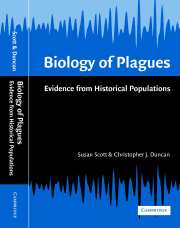Book contents
- Frontmatter
- Contents
- Preface
- Conversion table for imperial to metric units
- 1 Introduction
- 2 Epidemiological concepts
- 3 The biology of bubonic plague
- 4 The Great Pestilence
- 5 Case study: the plague at Penrith in 1597–98
- 6 Pestilence and plague in the 16th century in England
- 7 Plagues in the 16th century in northern England: a metapopulation study
- 8 Plagues in London in the 17th century
- 9 Plagues in the provinces in the 17th century
- 10 Plague at Eyam in 1665–66: a case study
- 11 Continental Europe during the third age of plagues: a study of large-scale metapopulation dynamics
- 12 The plague at Marseilles, 1720–22: an outbreak of bubonic plague?
- 13 Conclusions
- References
- Index
8 - Plagues in London in the 17th century
Published online by Cambridge University Press: 28 October 2009
- Frontmatter
- Contents
- Preface
- Conversion table for imperial to metric units
- 1 Introduction
- 2 Epidemiological concepts
- 3 The biology of bubonic plague
- 4 The Great Pestilence
- 5 Case study: the plague at Penrith in 1597–98
- 6 Pestilence and plague in the 16th century in England
- 7 Plagues in the 16th century in northern England: a metapopulation study
- 8 Plagues in London in the 17th century
- 9 Plagues in the provinces in the 17th century
- 10 Plague at Eyam in 1665–66: a case study
- 11 Continental Europe during the third age of plagues: a study of large-scale metapopulation dynamics
- 12 The plague at Marseilles, 1720–22: an outbreak of bubonic plague?
- 13 Conclusions
- References
- Index
Summary
We saw in Chapter 6 that plague broke out sporadically in London throughout the 16th century, each epidemic lasting about 9 months during the spring, summer and autumn but it was persistent from 1578 (when there were 3568 plague deaths) to 1582 (2976 plague deaths) and then exploded again at the end of the century in 1593 (10 662 plague deaths) an outbreak that persisted through 1594 and 1595. Does this persistence of the epidemics for 3 to 5 years indicate a change in the epidemiology of the disease or had a new infection or mutation arrived? Some of these epidemics were confined to London, but some spread along the River Thames from Greenwich to Windsor and expanded northwards into the Home Countries, usually within a radius of 20 miles. There were also major epidemics in provincial England in the 16th century, some coincident with the outbreaks in London but, as a generalisation, it does not seem that London usually acted as a focus for these provincial outbreaks, although it frequently spread out to the Home Countries and along the Thames.
Figure 8.1 shows the plague deaths in London from 1578 until 1680 and the three terrible epidemics of the 17th century can be seen. Figure 8.1 is deceptive because the scale on the ordinate necessary to cover the enormous mortality of 1665 disguises the fact that the plague was almost endemic, with deaths in London in most years from 1603 to 1679, although at a low level; this is revealed more clearly in Fig. 8.2 where the annual plague deaths are plotted on a logarithmic scale.
- Type
- Chapter
- Information
- Biology of PlaguesEvidence from Historical Populations, pp. 192 - 224Publisher: Cambridge University PressPrint publication year: 2001



